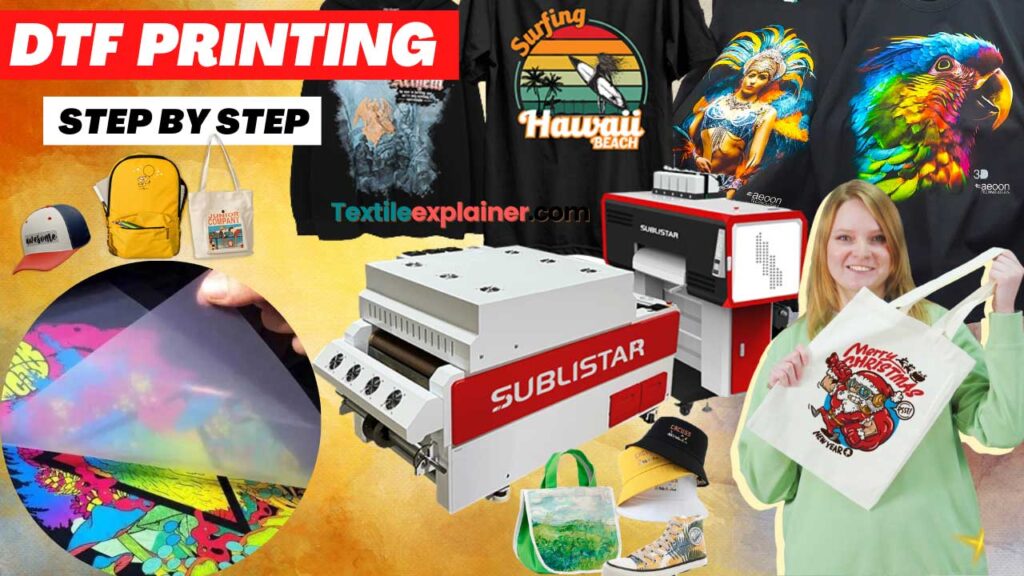DTF Printing Change: Releasing Creativity in Fabric Layout and Production
Wiki Article
Ultimate Overview to DTF Printing Techniques for Sensational Textile Layouts
Beginning on the journey of grasping DTF printing strategies can open a globe of opportunities for developing aesthetically exciting fabric designs. As the fabric industry proceeds to progress, staying in advance of the curve with cutting-edge printing approaches is essential. In this guide, we will explore the elaborate information of DTF printing, from grasping the basic fundamentals to unraveling advanced color techniques that can elevate your styles to brand-new heights. Keep tuned as we look into the nuances of choosing the ideal materials, improving the printing process, and getting over typical challenges to accomplish spectacular results.Comprehending DTF Printing Essentials
DTF printing, a process that includes moving layouts from an unique film to fabrics utilizing heat and pressure, creates the foundation of fabric printing strategies. This ingenious method permits high-quality, vibrant designs to be flawlessly transferred onto various materials with accuracy and detail. The very first step in DTF printing involves creating or selecting a style that will be printed onto the textile. This style is then printed onto an unique movie making use of a DTF printer, which uses certain dyes or pigments to guarantee color accuracy and durability.The final outcome is a stunning, resilient fabric style that is washable, versatile, and immune to fading. Overall, comprehending the essentials of DTF printing is important for understanding this modern-day textile printing strategy.
Picking the Right Fabric Products
Having established the fundamental principles of DTF printing strategies for fabric styles, the following crucial consideration lies in picking the proper fabric products to match this ingenious procedure successfully. Additionally, the stretchability of these materials can accommodate the warmth transfer procedure involved in DTF printing without misshaping the layout. By selecting the appropriate fabric products, designers can make the most of the capacity of DTF printing to produce spectacular and long-lasting textile styles.
Mastering the Printing Process
To succeed in DTF printing methods for textile styles, mastering the printing process is vital for attaining regular and high-grade results. The temperature, stress, and period of warm application need to be carefully controlled to make sure proper attachment of the design to the textile. By refining each of these steps in the printing process, developers can constantly generate sensational and durable fabric layouts with DTF printing strategies.
Enhancing Layouts With Shade Strategies

Moreover, trying out shade gradients can bring a feeling of activity and fluidness to the layout. By mixing shades flawlessly, a gradient impact can be achieved, including a modern and dynamic touch to the fabric style. Furthermore, making use of color obstructing techniques can develop striking and bold visuals by comparing different strong colors in distinctive areas of the design.
Additionally, integrating metallic or neon colors can provide a attractive and one-of-a-kind aspect to the fabric layout, making it stand out and exude a sense of vibrancy. When purposefully used, these see shade strategies can elevate the general visual charm of fabric layouts, making them much more memorable and fascinating.
Troubleshooting Common DTF Printing Issues
After checking out various shade methods to improve textile layouts, it is vital to resolve common DTF printing problems that might develop throughout the manufacturing procedure. In addition, concerns with picture clearness and sharpness can take place due to low-resolution pictures or inappropriate printing methods. By being conscious of these common troubles and implementing the essential troubleshooting actions, you can enhance the total top quality of your DTF published fabric layouts.Verdict
Finally, mastering DTF printing techniques is essential for producing sensational textile styles. By recognizing the essentials of DTF printing, picking the appropriate materials, and improving layouts with color methods, one can accomplish remarkable results. It is necessary to fix typical issues that might develop throughout the printing process to make sure an effective outcome. With method and interest to detail, one can produce lovely and special fabric designs using DTF printing strategies.DTF printing, a process that entails transferring designs from an unique movie to fabrics utilizing warmth and stress, creates the foundation of fabric printing techniques.Having actually developed the fundamental concepts of DTF printing techniques for textile styles, find more information the following essential consideration lies in picking the ideal fabric products to match this innovative procedure efficiently. By picking the ideal textile materials, developers can make best use of the capacity of DTF printing to produce stunning and durable fabric styles.
To stand out in DTF printing methods for fabric designs, mastering the printing procedure is necessary for achieving consistent and premium outcomes. DTF Printing. By sharpening each of these steps in the printing process, designers can consistently produce durable and magnificent textile designs with DTF printing strategies
Report this wiki page